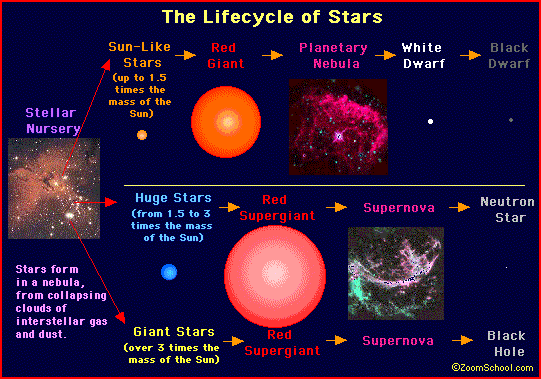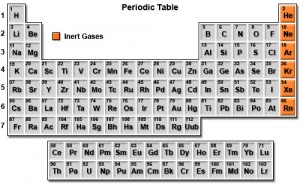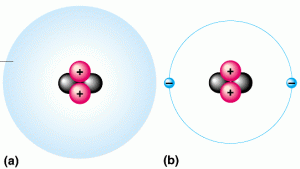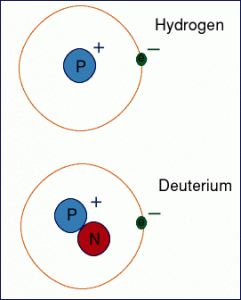Creation: Stellar Evolution Part I
 A guest post today from my brilliant husband, Gregg.
A guest post today from my brilliant husband, Gregg.
The 6 types of evolution taught in the average public school today, the first 5 being types of Darwinian evolution, and the last being simple modifications within kind or changes within kind and not even technically “evolution,” are:
- Cosmic evolution
- Stellar evolution
- Chemical evolution
- Abiogenesis—Life from non-life
- Macro-evolution
- Micro-evolution (Actually takes place but is not really evolution)
Stellar evolution
Steller evolution is the theory of the origin of stars, or how stars “evolved.” The theories of stellar evolution can be largely separated into two categories. There are theories that fall into how stars “evolved” as part of the aftermath of the Cosmic Evolution brought about by the Big Bang, and there are other theories about how stars are “evolving” even today.
 The current theories of steller evolution would have us believe that big gas clouds and nebulae in outer space are giant “Stellar Nurseries” where gas is “condensing” into “proto-stars” or “population III stars” or “first-generation stars” pick your authoritatively scientific sounding catchphrase. Now, if I spent all of my time living on government grants while peering into the sky, and I told you that nebulae in outer space are giant “Stellar Nurseries” and every time some dust moves out of the way and stars behind them appear brighter, I jump up all excited and point and yell, “SEE! SEE! A STAR IS BORN!” Would that not sound as if some great scientific truth had just been revealed?
The current theories of steller evolution would have us believe that big gas clouds and nebulae in outer space are giant “Stellar Nurseries” where gas is “condensing” into “proto-stars” or “population III stars” or “first-generation stars” pick your authoritatively scientific sounding catchphrase. Now, if I spent all of my time living on government grants while peering into the sky, and I told you that nebulae in outer space are giant “Stellar Nurseries” and every time some dust moves out of the way and stars behind them appear brighter, I jump up all excited and point and yell, “SEE! SEE! A STAR IS BORN!” Would that not sound as if some great scientific truth had just been revealed?
Of course, it’s a bunch of hooey. The same science that prevents stars from”evolving” as a result of a fictitious Big Bang is the same science that prevents stars from being born in “Stellar Nurseries” no matter how authoritatively scientific that phrase sounds when describing big clouds of incredibly rarified dust and gas.
 The problem Darwinists face is that even by the most imaginative calculations, the Big Bang cannot produce any elements heavier than Lithium. The most widely accepted theories only make hydrogen and helium. Those are only 2 of the 92 natural elements. So, how do we get the other 90 and specifically how do we get the elements heavier than iron? Simply put, the fairy tale that stars are evolving now or evolved out of the imaginary Big Bang is the required rationalization that explains the creation of these other elements.
The problem Darwinists face is that even by the most imaginative calculations, the Big Bang cannot produce any elements heavier than Lithium. The most widely accepted theories only make hydrogen and helium. Those are only 2 of the 92 natural elements. So, how do we get the other 90 and specifically how do we get the elements heavier than iron? Simply put, the fairy tale that stars are evolving now or evolved out of the imaginary Big Bang is the required rationalization that explains the creation of these other elements.
As I covered in the previous posts, gas in outer space doesn’t condense. To answer this problem, a fairly famous agnostic astronomer once theorized that if 4 or more stars exploded near a gas cloud at the same time, that would provide enough energy to compress the gas cloud into a new star. Oh, really? So, four stars surrounding a cloud of gas all blow up at once? Well, that probably happens every day. Seems very likely. And, just to get my math right, we are trading 4 old stars in for 1 new one? Is that like the broom salesman who purchases brooms for a dollar each and sells them for 20 cents? “Honey, I got killed out there today. I lost a lot of money. But I’ll make it up on volume.”
The Big Bang theory of Stellar Evolution says that the Proto-Stars, once magically formed, repeatedly exploded. Billions upon billions of stars kept exploding, for billions of years. Gradually, these explosions are said to have produced all of the heavier elements.
I have already shown that gas doesn’t condense, angular momentum cannot be applied without some outside force acting on it, and centripetal force would dissipate said gas anyway. So, once more I must set aside reason, logic, and common sense, and develop an ability to ignore scientific facts in order to assume that Stellar Evolution could happen anyway. In that case, there are still hundreds of factual scientific reasons why Stellar Evolution cannot occur.
The main logical reason that this theory is a bunch of hooey is very simple. Once something explodes, it never explodes again. If you don’t believe this, try making the same firecracker explode more than once. Even if you reassemble its constituent parts after the initial explosion, you are going to have an ignition problem and a fuel problem. Those two problems will combine to be insurmountable 100% of the time.
 The main scientific reason why it cannot occur is called the helium mass 4 gap, that is, there is a gap immediately after helium 4. The nuclear gaps at mass 5 and 8 make it impossible for hydrogen or helium to change itself into any of the heavier elements. So, even discarding logic to assume that stars can explode over and over, exploding stars could not produce the heavier elements.
The main scientific reason why it cannot occur is called the helium mass 4 gap, that is, there is a gap immediately after helium 4. The nuclear gaps at mass 5 and 8 make it impossible for hydrogen or helium to change itself into any of the heavier elements. So, even discarding logic to assume that stars can explode over and over, exploding stars could not produce the heavier elements.
Some scientists speculate that some heavier elements might be produced, but even that would not be enough to supply all the heavier elements now in our universe. Among nuclides that can actually be formed, gaps exists at mass 5 and 8. Neither hydrogen nor helium can jump the gap at mass 5. This first gap is caused by the fact that neither a proton nor a neutron can be attached to a helium nucleus of mass 4. Because of this gap, the only element that hydrogen can normally change into is helium.
 Okay, but EVEN IF it spanned this gap, which, as I said, it cannot, then it would be stopped again at mass 8. Hydrogen bomb explosions produce deuterum (hydrogen 2), which, in turn, forms helium 4. In theory, the hydrogen bomb chain reaction of nuclear changes could continue changing into ever heavier elements until it reached uranium; but the process is stopped at the gap at mass 5. Darwinists theorize that our very own sun burns by means of fusion. If it were not for that gap, our own sun would radiate uranium toward us instead of just heat and light.
Okay, but EVEN IF it spanned this gap, which, as I said, it cannot, then it would be stopped again at mass 8. Hydrogen bomb explosions produce deuterum (hydrogen 2), which, in turn, forms helium 4. In theory, the hydrogen bomb chain reaction of nuclear changes could continue changing into ever heavier elements until it reached uranium; but the process is stopped at the gap at mass 5. Darwinists theorize that our very own sun burns by means of fusion. If it were not for that gap, our own sun would radiate uranium toward us instead of just heat and light.
Okay, so EVEN IF hydrogen spanned the mass 5 gap which is impossible, it still is completely impossible to span the mass 8 gap.
One really does not have to be a nuclear surgeon or brain scientist to understand this. If you will look at any standard table of the elements, you will find that the atomic weight of hydrogen is 1.008. Deuterum is a form of hydrogen with a weight of 2.016. Next comes helium with an atomic weight of 4.003, followed by lithium at 6.939, beryllium 9.012, boron 10.811, and so forth. As you can see, gaps in atomic weight exist at mass 5 and 8.
Stellar Evolution theories depend upon hydrogen being able to cross these gaps due to explosive forces. So, the real question is can hydrogen explosions cross those gaps? And the answer, as you probably already guessed, is No.
Nuclear fission like that which occurs in a nuclear bomb explosion or in a nuclear reactor, splits uranium into unstable uneven halves of barium and technetium. Nuclear fusion like that seen in a hydrogen bomb explosion combines, or doubles, hydrogen into deuterum (helium 2), which then doubles into helium 4, and then it stops there. These types of reactions begin with radioactive elements that are MUCH heavier than hydrogen and helium and cannot accomplish what Stellar Evolution theorizes. A hydrogen explosion, even in the heart of a star, does not span the mass 5 gap, and never reaches the mass 8 gap.
 To make up for this, Darwinists speculate that the explosions of the early proto-stars were special. They were extra super duper hot, apparently, and that super duper unbelievable heat could theoretically account for mass spanning the gaps because you are adding energy. There really isn’t a good scientific reason why simple hydrogen and helium stars should explode over and over and over, and there really isn’t a good scientific reason why those explosions would be extra special super spicy habenaro hot. The only justification, really, is to make this idiotic theory seem plausible and make the math work out, kind of like Ptolemy adding his orbital epicycles.
To make up for this, Darwinists speculate that the explosions of the early proto-stars were special. They were extra super duper hot, apparently, and that super duper unbelievable heat could theoretically account for mass spanning the gaps because you are adding energy. There really isn’t a good scientific reason why simple hydrogen and helium stars should explode over and over and over, and there really isn’t a good scientific reason why those explosions would be extra special super spicy habenaro hot. The only justification, really, is to make this idiotic theory seem plausible and make the math work out, kind of like Ptolemy adding his orbital epicycles.
But okay, let’s make the super ridiculous hot explosion assumption. Fine. I have abandoned reason once more to make that assumption. Now we are looking at a monopole problem again. Heat that theoretically tremendous should also theoretically produce monopoles, as long as we are being theoretical, and — factually — there are none in the known universe.
The Truth:
The truth is that stars don’t “evolve” no matter how badly Darwinists wish that were the case. The truth is that stars are created things, like every other created thing. Stars were created by God, the most imaginative and amazing Creator in the known universe.
The truth is that the first chapter of Genesis highlights the scientifically accurate and logically sound story of how almighty God created everything. He created light and darkness. He created the waters and the dry land. He created all the plants. He created every living thing in the water, on dry land, and the birds of the air. He created the moon and the sun.
The Bible goes into great detail about all of those acts of creation and carefully details how God created man, male and female created he them, his finest creations. In all of those words describing the God of wonders whose hand crafted everything that has ever existed and everything that exists today, there is one sentence that fully explains how the stars and the galaxies came to be. That one sentence reads like this:
Genesis 1:16 …He made the stars also.
God bless you and yours. Gregg
Resources:
Additional Posts dealing with Creation and Darwinism


“One really does not have to be a nuclear surgeon or brain scientist to understand this.” This made me LOL. Yes, I was paying attention to my “lesson” and this tripped me up a little. Then, I realized/assumed the healthy dose of humor was meant to lighten the load on the good ol’ noggin a little bit. I enjoyed this Gregg! Thanks! Meg.
P.S. This is a smidge off topic, however, I would be interested to know your thoughts on the discovery of Ardi in Ethiopia? If she, indeed, lived 4.4 million years ago, what do you think this does with respect to polarizing Christianity and Science even more? How do we, as Christians, grapple with the (new) timeline and the newly discovered evidence to purportedly support this?
I am never at a loss for words and I usually look forward to a little heated, healthy debating. Unfortunately, I am less schooled than I would like to be as far as defending my position. Any thoughts would be greatly appreciated. In Him, M.
Hi Meg,
I intend to go in depth into the various 5 Darwinian Evolution tenets. I hope I put Big Bang to bed in the previous posts. My approach to each will mirror that. First I will explore the history of that Darwinian tenet, then evaluate its logical merit, then evaluate its mathematical and scientific soundness, look at any supporting evidence, then explore any cultural effects.
Suffice to say the evidence for a young earth is plentiful. As for the rest, I counsel patience, Grasshopper.
In Christ,
Gregg
Hi Gregg,
.
I’m pretty sure the guys who thought of gas clouds being compressed by 4 stars would have thought of your objections. Perhaps you misunderstood what they were saying. Did you read what they were saying? Where did you read it from? The accepted idea about star formation is that gas clouds collapse under gravity. If gravity is strong enough to hold the earth in its orbit then it’s strong enough to compress gas.
.
You’ve certainly misunderstood the problem of fusing elements beyond Helium. For a start, you’re quoting the atomic weights of isotopes along side the atomic weights of elements as found on earth.
.
The values you’ve quoted for Hydrogen are 1.008 and 2.016 which are the weights of the isotopes Hydrogen-1 and Hydrogen-2 (also known as Deuterium). But you’ve quoted Lithium’s atomic weight as 6.939 which is not the atomic weight of either Lithium-6 or Lithium-7. It’s pretty much the same as the number I found (6.941) for the atomic weight of naturally occurring Lithium on earth. That assumes a sample which contains 7.6% Lithium-6 and 92.4% Lithium-7. Given that Lithium-6 has an atomic weight of 6.015 and Lithium-7 has an atomic weight of 7.016, the atomic weight of the element as a whole ends up somewhere between the two, but closer to the Lithium-7 value because there’s more Lithium-7 than there is Lithium-6. Needless to say, the properties of samples found on earth are irrelevant to what goes on in stars. We need to be looking just at the properties of isotopes.
.
The gap at mass 8 is most important. In fact it’s not a gap. The isotope Beryllium-8 has an atomic weight of 8.005. The only problem is that it rapidly decays into two Helium-4 nuclei. Physicists recognised this as a problem and found a solution. If the star is hot enough and rich enough in Helium-4, Beryllium-8 can be formed rapidly enough that there’s always a little bit of it around. If Helium-4 reacts with this Beryllium-8 before it decays, you get Carbon-12 which is very stable. It’s called the triple alpha process.
.
May peace be with you,
Neil.
Let me see if I follow your points. First, you claim that the guys who thought of trading 4 stars for 1 already have an answer to my objections — but you don’t state it.
.
Then, you claim that I’ve misunderstood the problem of fusing elements beyond Helium. Your basis is that I don’t quote the proper atomic weight for Lithium and you prove it by showing that I — well — quoted the proper atomic weight for Lithium.
.
Then, you state that the mass gap 8 is more important than either mass gap that I explain — though you do not address either of those two — and then go on to admit that it really isn’t a gap.
.
All very salient and cogent arguments. Thank you.
Dear Sir,
I’m a homeschooling dad. Question about mass gaps at 5. Here’s what an atheist on my f/b forum came up with mocking me:
What about Helium 3?
http://en.wikipedia.org/wiki/Helium-
“atomic gap at weight 5. that you get to 6 by combining two atoms of helium-3.”
“for those of you who may not know, the periodic table of elements isn’t EVERYTHING that exists. it’s just the most common ones. there are multiple isotopes of many of those elements.”
That was a question posed to me by an atheist. What say you?
I”m confused.
I hate to say this but your atheist friend apparently has insufficient understanding of quantum field theory to even have this conversation and I really am not in the business of teaching them what they are supposed to believe as atheists and then rehashing to show just how wrong it is.
While there are nine known isotopes of helium (He) (standard atomic mass: 4.002602(2) u), only helium-3 (3He) and helium-4 (4He) are stable. All radioisotopes are short-lived, the longest-lived being 6He with a half-life of 806.7 milliseconds. The least stable is 5He, with a half-life of 7.6×10−22 seconds, although it is possible that 2He has an even shorter half-life. While they have the mass, they do not REACT beyond mass gap 5.
If there were no mass gaps, there would be nothing but a universe of uncontrolled reactions and all matter in the universe would have already converted into energy. The fact that mass gaps exist is why reactions stop reacting. Mass gaps are about reactions, not about the mass of the atoms.
Two hydrogen atoms can combine to form a single helium atom with a mass of 4 (He, actual mass 4.002602). That is not respective of the mass gap at 5. That is just the mass of the element. There is a mass gap at 5 which means that REACTIONS stop there. Think of a hydrogen bomb that never stopped reacting. The reason it stops reacting is because that reaction cannot span mass gap 5.
Now, imagine that the ONLY elements that exist in the so-called primordial universe are hydrogen and helium. Question: How do you create reactions with those light elements that create heavier elements? Answer: You don’t. It is impossible.
Does that help?
Thank you Gregg!!!
I actually get the answer. Imagine that? Ha-not me.
Wow-had you been around in my youth perhaps I could’ve majored in Biology or Chemistry! I really like it but I don’t understand it.
Thanks a relieved homeschool Dad,
Dave
Your essay was written almost 4 years ago and it seems likely that you haven’t had the time since then (and may still not have the time now) to revisit the material. It seems possible to me that your original source or sources were not accurate about the problem of the mass gaps at 5 and 8. All I know about this is a result of google and wikipedia and references from those sites, but what is coming up for me in those searches agrees with Neil’s mention of the triple alpha process as an explanation of the formation of carbon (with heavier and lighter elements resulting from various processes acting on carbon etc.). There were review articles by Burbidge, Burbidge, Fowler and Hotly in 1957, and by Wallerstein et al in 1997 that some sources cite.
(Hoyle, not Hotly above)
Explain to me please how the universe, earth and man are all 6,000 years old as some state IAW bible. I do not get that. That limits God to a man defined timescale when His creation screams otherwise. Thank you.
Well, Elaina, to answer your question, I believe in a Being of infinite supremacy and sovereignty Who I hope we can agree to refer to as “God” or the “Creator” and that Being is not limited by anything at all. Everything is His creation and so subject to His divine will. He is infinitely powerful, infinitely omnipotent, and infinitely knowledgeable.
Chambers puts it this way in MY UTMOST FOR HIS HIGHEST by saying (paraphrasing), “Imagine God. Hold that thought. Now understand that God is at least a million times greater than what you just thought so imagine that. NOW understand that God is at least a million times greater than what you just reconsidered so imagine that. Now repeat into infinity. THAT is God.”
Here are some scenarios to consider. Given that God is GOD, then if the God I believe in so desired, He could have created absolutely EVERYTHING including the entire universe and time exactly 5 minutes and 12 seconds ago — complete with memories and a world full of evidence of past ages. He could have (to quote the Bible) “stretched out the heavens” in the very blink of an eye. He could have simply spoken it ALL into existence because He is not subject to nature or nature’s laws. He created nature and nature’s laws. He is supernatural and supreme.
Or, if He so chose, He certainly could have planted a little seed of “condensed” nothing and let it “explode” billions of years ago.
The reason that I believe that neither of the above scenarios is true is because God’s word clearly spells out how He created everything, in what order, and in what amount of time. And God is not a man that He should lie.
If God’s word says something, according to my way of thinking, then He is the ultimate authority and I can safely take Him at his word. If man says differently, it is likely the sinful nature of man. I could cite hundreds of examples of that. Man says it’s okay to gas Jews and put them in a furnace — God says thou shalt not kill. Who’s right? Man says it’s perfectly fine to commit adultery. God’s word says otherwise. Who is right? Man says it’s perfectly fine to disown your parents. God’s word says to honor your mother and father. Which is right?
For me, that is quite enough. And if I ere, I try to do so on the side of prudence because, after all is said and done, whether the universe is 5 minutes old or 5 gabillion jillion years old doesn’t change God. He is the same yesterday, today, and forever. There are some mysteries I will not solve in my lifetime and there are some mysteries that are not the key to my salvation.